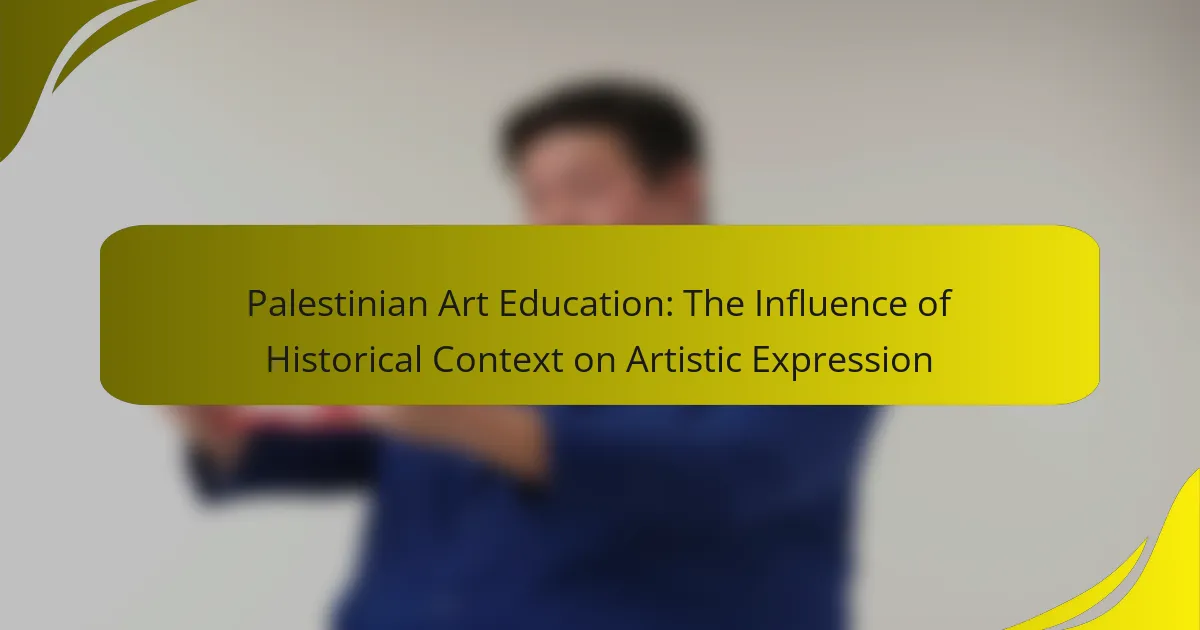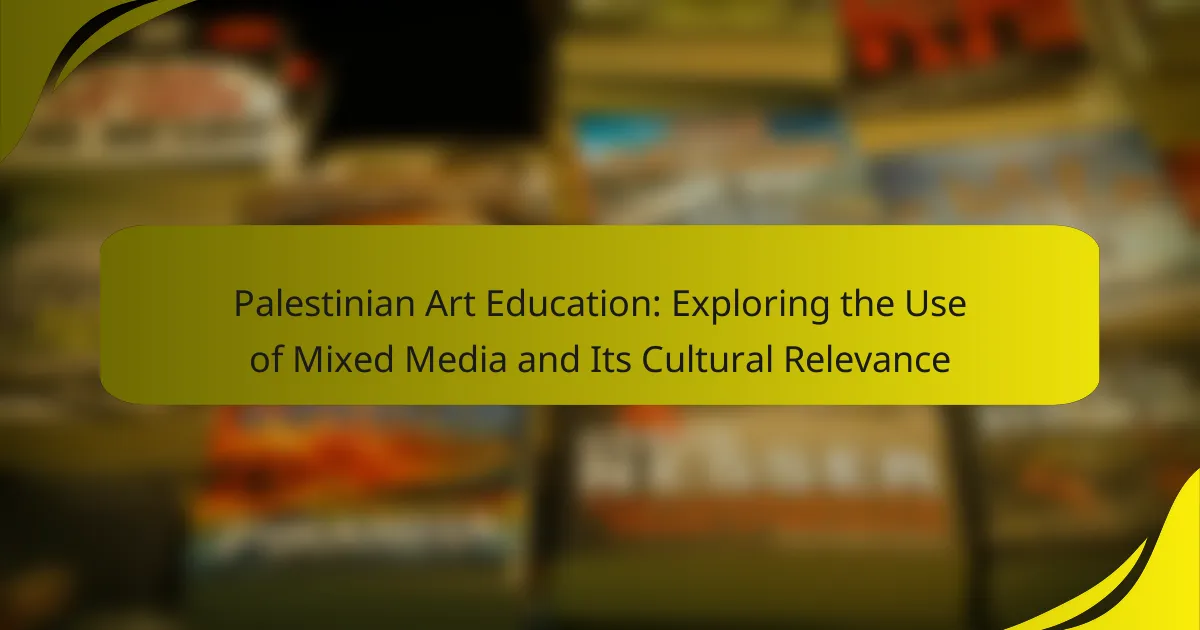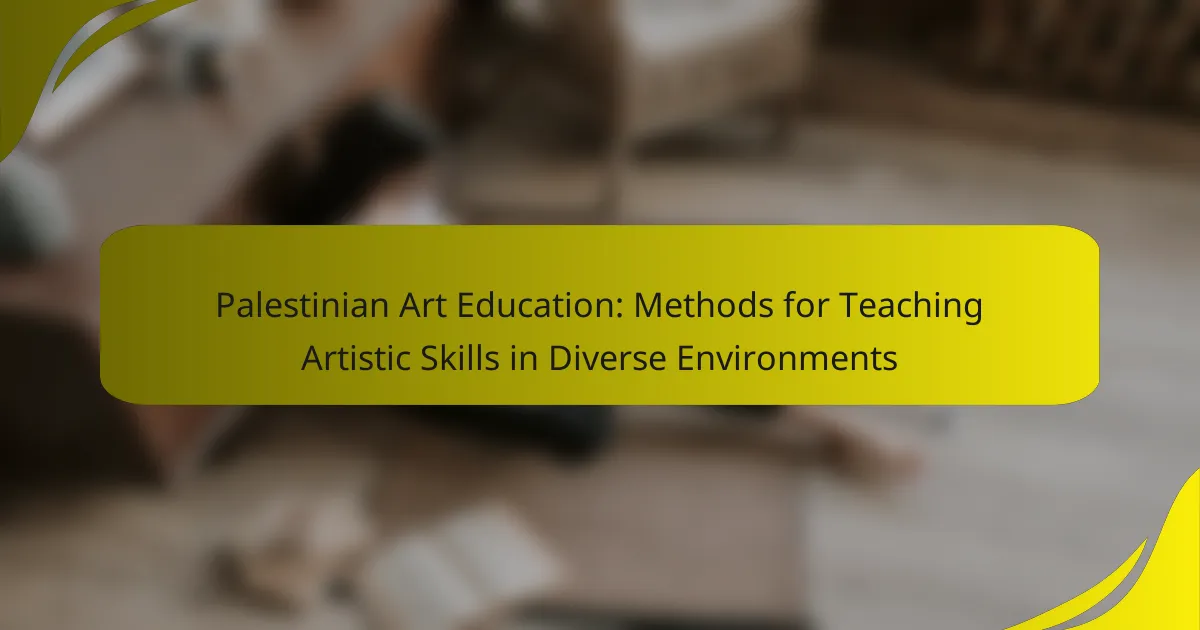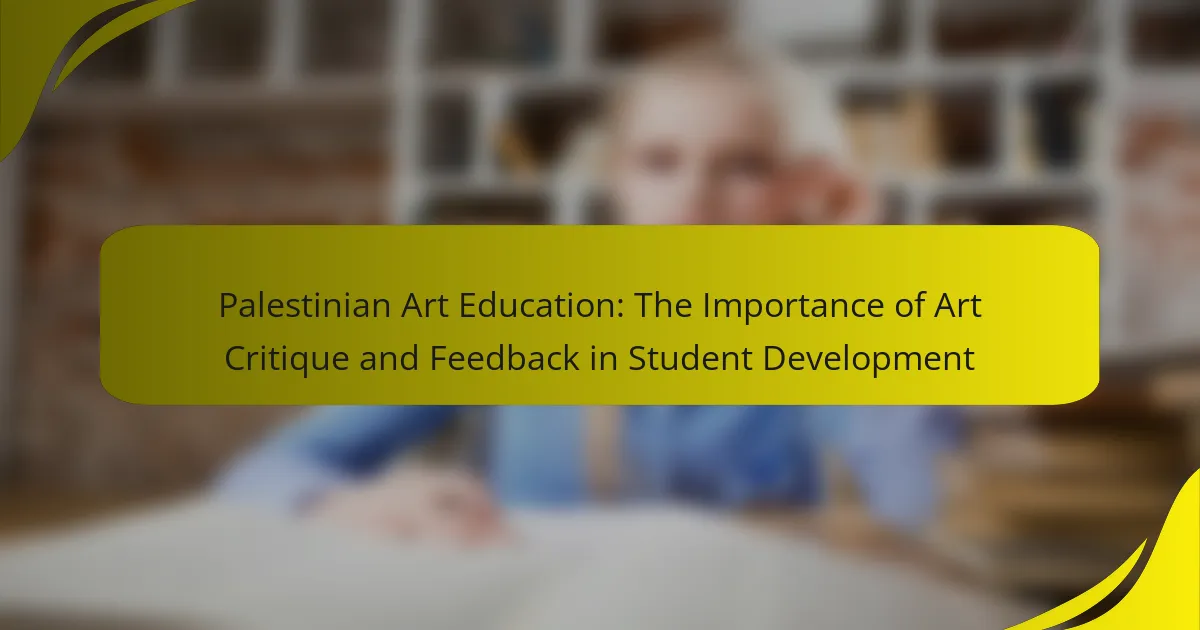Palestinian Art Education is the structured teaching and learning of artistic practices that reflect Palestinian culture, incorporating both traditional techniques and modern methodologies. This educational framework emphasizes visual arts, crafts, and performance, aiming to preserve cultural heritage and foster identity expression. Key components include traditional methods such as embroidery, pottery, and calligraphy, alongside community engagement initiatives that encourage collaboration among artists, educators, and students. The impact of art education in Palestine extends to enhancing emotional well-being, critical thinking, and social skills, while also addressing historical narratives and contemporary issues faced by Palestinians, ultimately contributing to a cohesive and resilient society.
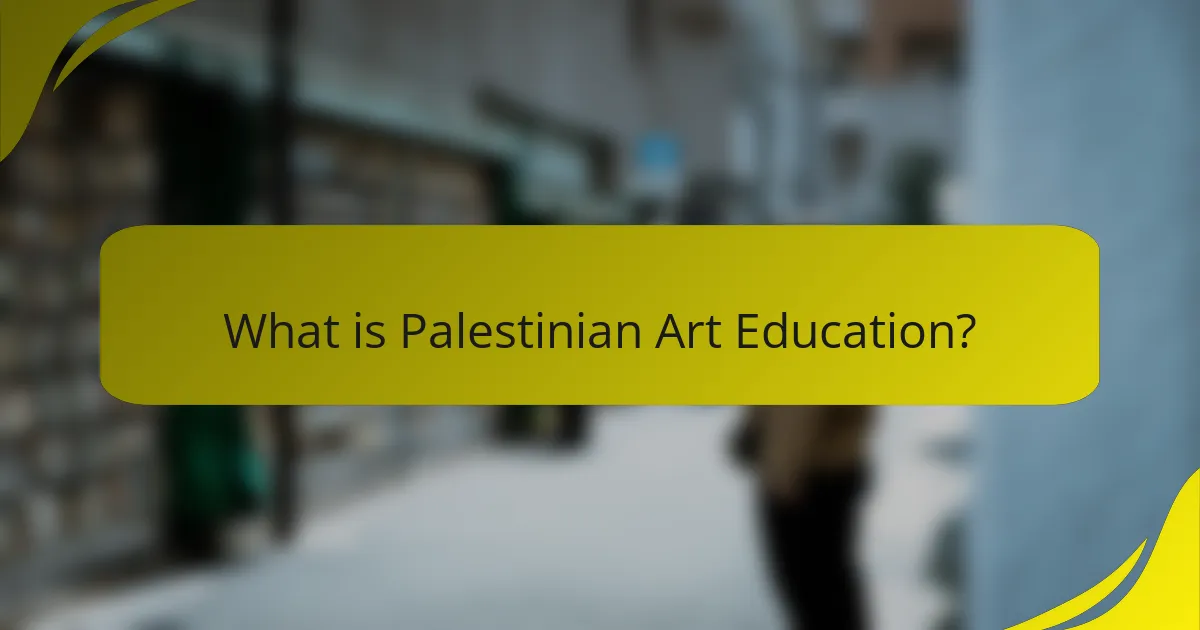
What is Palestinian Art Education?
Palestinian Art Education refers to the teaching and learning of artistic practices within Palestinian culture. It encompasses various traditional techniques and modern approaches. The curriculum often includes visual arts, crafts, and performance. Key elements involve the preservation of cultural heritage and expression of identity. Art education in Palestine aims to empower individuals through creativity. It fosters critical thinking and cultural awareness among students. Institutions like universities and community centers play significant roles in this education. Programs often highlight historical narratives and contemporary issues faced by Palestinians.
How does Palestinian Art Education reflect cultural identity?
Palestinian Art Education reflects cultural identity by incorporating traditional motifs and narratives. It serves as a medium for expressing historical and social contexts. Students learn to create artworks that embody their heritage. Techniques passed down through generations are emphasized in the curriculum. These methods connect learners to their ancestors and cultural practices. Artworks often depict themes of resistance and resilience. This reinforces a collective identity among Palestinians. Furthermore, exhibitions showcase student works that highlight cultural pride. Such initiatives foster a sense of belonging and continuity within the community.
What traditional techniques are emphasized in Palestinian Art Education?
Palestinian Art Education emphasizes traditional techniques such as embroidery, ceramics, and calligraphy. Embroidery, known as “tatreez,” involves intricate patterns that reflect cultural identity. Ceramics often feature traditional motifs and are created using age-old methods. Calligraphy is a revered art form, showcasing Arabic script’s beauty. These techniques preserve Palestinian heritage and foster cultural continuity. They are taught in various educational settings, including community centers and schools. This approach enhances students’ appreciation of their cultural roots.
How do these techniques connect to Palestinian heritage?
Traditional techniques in Palestinian art are deeply intertwined with the region’s heritage. These techniques often reflect the history, identity, and cultural practices of the Palestinian people. For example, the art of olive wood carving is a prominent craft that symbolizes resilience and connection to the land. Additionally, traditional embroidery, known as tatreez, conveys stories and cultural narratives through intricate patterns. These art forms serve as a means of preserving cultural identity, especially in times of conflict. The use of natural dyes in textile arts also highlights the connection to the environment and local resources. Overall, these techniques not only represent artistic expression but also embody the collective memory and heritage of the Palestinian community.
Why is the study of traditional techniques important?
The study of traditional techniques is important for preserving cultural heritage. These techniques embody the history and identity of a community. They provide insights into the values and beliefs of past generations. Understanding traditional methods fosters a connection to cultural roots. This connection can enhance community cohesion and pride. Additionally, traditional techniques can inspire contemporary artistic practices. They often incorporate sustainable practices that are relevant today. The preservation of these techniques ensures they are passed down to future generations.
What role do traditional techniques play in artistic expression?
Traditional techniques serve as a foundational element in artistic expression. They provide artists with a means to connect with cultural heritage. These techniques often reflect historical narratives and community values. For example, traditional Palestinian embroidery, known as tatreez, conveys stories and identities. Artists utilize these methods to maintain cultural continuity. The use of traditional techniques fosters a sense of belonging and pride. They also allow for innovation within established forms. This blend of tradition and modernity enriches the artistic landscape.
How do these techniques influence contemporary Palestinian artists?
Traditional techniques significantly influence contemporary Palestinian artists. These techniques, rooted in historical and cultural practices, inform their artistic expressions. Artists incorporate methods like embroidery, pottery, and calligraphy into their work. This integration creates a dialogue between past and present. It allows artists to express identity and resistance through their art. The use of traditional techniques fosters a sense of community and belonging. Many artists aim to preserve cultural heritage while innovating within their art forms. For instance, the use of traditional motifs can symbolize resilience against oppression. This connection to heritage enriches contemporary Palestinian art’s narrative and impact.
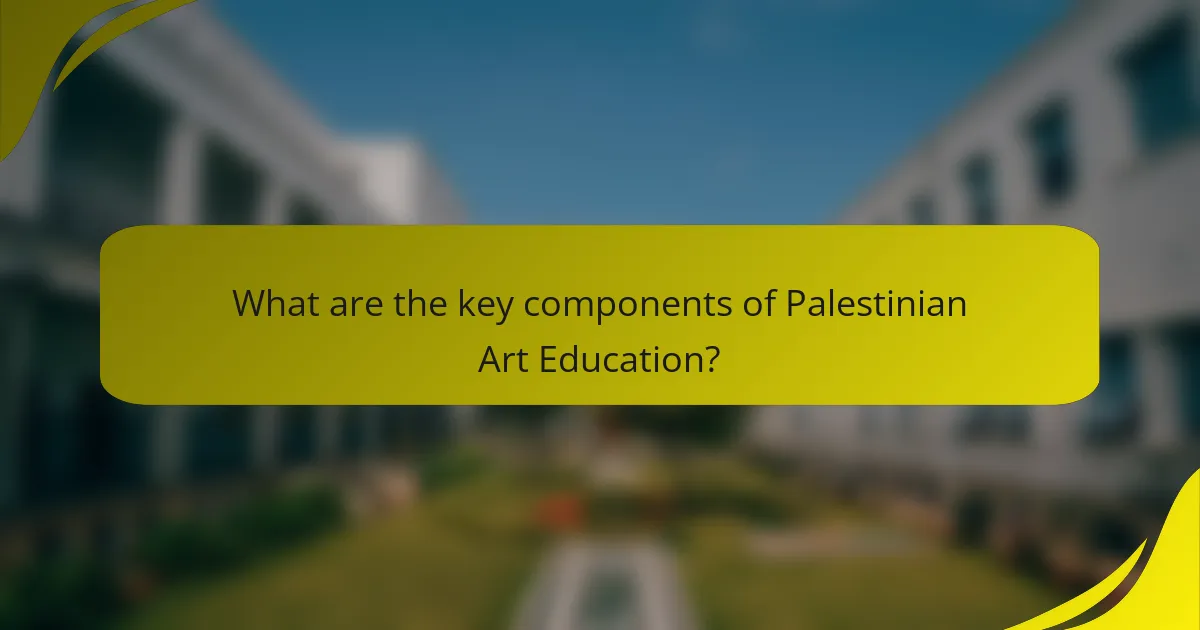
What are the key components of Palestinian Art Education?
Key components of Palestinian Art Education include traditional techniques, cultural significance, and community engagement. Traditional techniques encompass methods such as embroidery, pottery, and calligraphy. These techniques are deeply rooted in Palestinian heritage and history. Cultural significance emphasizes the expression of identity and resistance through art. Community engagement fosters collaboration among artists, educators, and students. This collaboration enhances the learning experience and promotes cultural preservation. Together, these components form a comprehensive framework for Palestinian Art Education.
What subjects are included in the curriculum of Palestinian Art Education?
The curriculum of Palestinian Art Education includes subjects such as painting, sculpture, and graphic design. Additionally, it covers traditional crafts like embroidery and ceramics. Students also learn about art history, focusing on Palestinian heritage and contemporary art movements. The curriculum emphasizes cultural significance and artistic expression. Workshops and practical sessions are integral to the learning process. These subjects aim to foster creativity and preserve cultural identity. Overall, the curriculum supports the development of artistic skills and cultural awareness among students.
How do these subjects enhance artistic skills?
Subjects in Palestinian art education enhance artistic skills by fostering creativity and cultural understanding. They provide students with traditional techniques that improve their technical abilities. For instance, learning calligraphy enhances precision and control in artistic expression. Engaging with cultural themes deepens emotional connection to the artwork. This connection encourages unique interpretations and personal styles. Studies show that immersive art education leads to improved problem-solving skills. Additionally, collaboration in art projects promotes teamwork and communication. Overall, these subjects cultivate a well-rounded artistic skill set through technique, culture, and collaboration.
What cultural narratives are taught through these subjects?
Palestinian art education teaches narratives of identity, resilience, and heritage. These subjects highlight the importance of cultural preservation in the face of adversity. They convey stories of historical struggles and the ongoing quest for recognition. Traditional techniques reflect the deep-rooted connection to land and community. Art serves as a medium for expressing collective memory and shared experiences. The narratives emphasize the significance of cultural symbols and practices. They foster a sense of belonging and pride among Palestinian youth. Through these subjects, students learn to articulate their cultural identity creatively.
How are traditional techniques taught in Palestinian Art Education?
Traditional techniques in Palestinian Art Education are taught through a combination of hands-on workshops and theoretical instruction. Students learn about historical art forms, such as embroidery and pottery, which are integral to Palestinian culture. Instruction often includes mentorship from experienced artisans who provide guidance on techniques and materials.
Educational programs emphasize the importance of cultural heritage and identity. Students engage in practical exercises to develop their skills in traditional crafts. This approach not only preserves techniques but also fosters a sense of community and continuity.
Art education institutions often collaborate with local artists to enhance the learning experience. Workshops may include demonstrations of traditional methods, allowing students to observe and practice. This immersive learning environment reinforces the significance of traditional art forms in Palestinian society.
What methods are used to teach these techniques?
Methods used to teach traditional Palestinian art techniques include hands-on workshops, demonstrations, and mentorship. Workshops allow students to practice techniques under guided instruction. Demonstrations showcase the application of techniques by experienced artists. Mentorship provides personalized guidance and feedback. These methods foster skill development and cultural appreciation. Research indicates that experiential learning enhances retention and understanding of artistic practices.
How do instructors incorporate cultural significance into their teaching?
Instructors incorporate cultural significance into their teaching by integrating traditional art techniques and historical context. They utilize specific Palestinian art forms, such as embroidery and pottery, to illustrate cultural heritage. Lessons often include discussions about the history and symbolism behind these techniques. Instructors may invite local artists to share personal experiences and cultural narratives. This approach fosters a deeper understanding of Palestinian identity among students. Research shows that culturally relevant pedagogy enhances student engagement and learning outcomes. Studies indicate that students who connect with cultural content demonstrate improved academic performance and personal growth.
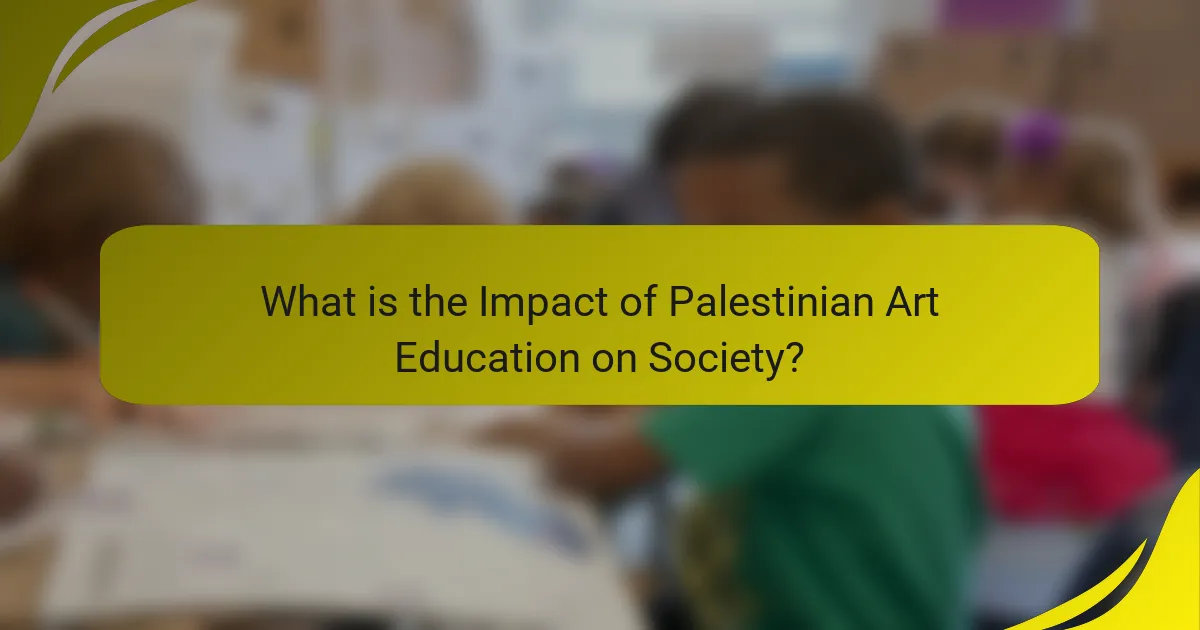
What is the impact of Palestinian Art Education on society?
Palestinian art education significantly impacts society by fostering cultural identity and community cohesion. It provides a platform for expressing historical narratives and contemporary issues. Art education encourages creativity and critical thinking among students. This form of education helps preserve traditional techniques and cultural heritage. Research indicates that students engaged in art education show improved emotional well-being and social skills. Programs often involve community projects, strengthening ties between individuals. The impact extends beyond the classroom, influencing broader societal perceptions of Palestinian culture. Ultimately, Palestinian art education plays a crucial role in shaping a resilient and unified society.
How does Palestinian Art Education foster community engagement?
Palestinian Art Education fosters community engagement by promoting cultural identity and collective expression. It utilizes traditional techniques that connect individuals to their heritage. Workshops and community art projects encourage collaboration among participants. These activities create a shared space for dialogue and creativity. Art education also addresses social issues, fostering awareness and activism. By showcasing local artists, it strengthens community bonds and pride. Events and exhibitions invite public participation, enhancing visibility of Palestinian culture. This engagement cultivates a sense of belonging and unity within the community.
What initiatives promote collaboration among artists and educators?
Initiatives that promote collaboration among artists and educators include community art programs and workshops. These programs often bring together professionals from both fields to create educational experiences. For instance, initiatives like the “Artist-in-Residence” programs allow artists to work directly with students. This fosters a hands-on learning environment. Additionally, partnerships between schools and local art organizations create opportunities for joint projects. Such collaborations enhance the curriculum with practical art experiences. Research shows that these initiatives improve student engagement and creativity. They also help preserve traditional techniques and cultural significance in art education.
How does art education contribute to cultural preservation?
Art education contributes to cultural preservation by teaching traditional techniques and fostering cultural identity. It enables individuals to learn and practice art forms that are significant to their heritage. This education helps pass down knowledge from one generation to the next. For example, Palestinian art education emphasizes traditional crafts like embroidery and pottery. These practices are vital for maintaining cultural narratives and expressions. Studies show that engaging in art education strengthens community ties and promotes a sense of belonging. Additionally, art serves as a medium for storytelling, preserving historical contexts and values. Thus, art education plays a crucial role in sustaining cultural practices and identities.
What challenges does Palestinian Art Education face?
Palestinian Art Education faces significant challenges. Limited resources hinder access to art materials and facilities. Political instability affects the educational environment and curriculum development. Cultural restrictions can stifle creative expression among students. Economic factors lead to reduced funding for art programs. Additionally, a lack of trained educators in art disciplines limits quality instruction. These challenges collectively impact the growth and sustainability of art education in Palestine.
How do political and social factors affect art education?
Political and social factors significantly influence art education in Palestine. The ongoing conflict and occupation create challenges for access to resources and safe learning environments. These circumstances often limit curriculum development and teacher training opportunities. Social dynamics, such as community values and cultural heritage, shape the content taught in art classes. For instance, traditional techniques may be emphasized to preserve cultural identity. Additionally, political narratives can dictate the themes explored in student artwork. This interplay affects students’ engagement and expression in their artistic endeavors. Research indicates that art education can serve as a form of resistance and empowerment in politically charged contexts.
What resources are needed to overcome these challenges?
To overcome challenges in Palestinian art education, several resources are needed. These include access to trained educators who understand traditional techniques. Funding is essential for materials such as paints, brushes, and canvases. Workshops and training programs can enhance skills in these techniques. Collaboration with cultural institutions can provide support and visibility. Additionally, community engagement is crucial for fostering interest in traditional art. Digital platforms can also facilitate wider access to educational resources. These resources collectively address the barriers faced in promoting Palestinian art education effectively.
What are some best practices for enhancing Palestinian Art Education?
Integrating community engagement is a best practice for enhancing Palestinian Art Education. This approach fosters collaboration between artists and local communities. Workshops and collaborative projects can create a sense of ownership and cultural pride. Incorporating traditional techniques into the curriculum strengthens cultural identity. Teaching methods should include hands-on experiences with local art forms. Utilizing local materials in art projects can connect students to their heritage. Partnering with cultural organizations enhances access to resources and expertise. Finally, promoting art exhibitions showcases student work and raises awareness of Palestinian culture.
How can traditional techniques be integrated into modern education?
Traditional techniques can be integrated into modern education through a structured curriculum that incorporates cultural heritage. This approach allows students to learn artistic skills while appreciating their historical context. For instance, Palestinian embroidery techniques can be taught alongside contemporary design methods. Workshops can be organized to provide hands-on experience with traditional art forms. Collaboration with local artisans can enhance the learning experience. Educational institutions can host exhibitions showcasing traditional art alongside modern interpretations. Research indicates that integrating cultural techniques fosters student engagement and identity. A study by the National Art Education Association highlights the benefits of cultural relevance in art education.
What role do community programs play in supporting art education?
Community programs play a crucial role in supporting art education by providing resources and opportunities for engagement. They often offer workshops, classes, and exhibitions that enhance artistic skills. These programs can foster cultural appreciation and awareness, especially in specific contexts like Palestinian art. They also create platforms for local artists to share their work and connect with the community. Research indicates that community involvement increases student participation in art education. For example, a study by the National Endowment for the Arts found that community-based art programs improve access to art education for diverse populations. Overall, community programs enrich the educational landscape by making art more accessible and culturally relevant.
Palestinian Art Education encompasses the teaching of artistic practices within Palestinian culture, emphasizing traditional techniques such as embroidery, ceramics, and calligraphy. The curriculum aims to preserve cultural heritage and foster identity through creative expression, critical thinking, and community engagement. Key components include a focus on historical narratives, contemporary issues, and the integration of traditional methods into modern education. The article also addresses challenges faced by art education in Palestine, including limited resources and political factors, while highlighting best practices for enhancing educational experiences and promoting cultural preservation.
